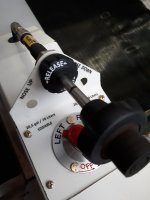[email protected]
I'm New Here
Hello,
I am finishing my 9 left elevator and at the point to decide on electric or manual trim. I originally planned to go electric but have read many post stating manual is the way to go. I have flown many aircraft with both manual and electric and do like electric in some cases. But with a small light plane like the rv9 it seems simple might be better. The vernier cable would be very simple and reliable compare to the little ray allen servo that could be problems sooner or latter.
I do plan to install a good 2 axis autopilot.
With manual how and where is the trim position indicated for take off?
Any advise is appreciated.
Thank you!
I am finishing my 9 left elevator and at the point to decide on electric or manual trim. I originally planned to go electric but have read many post stating manual is the way to go. I have flown many aircraft with both manual and electric and do like electric in some cases. But with a small light plane like the rv9 it seems simple might be better. The vernier cable would be very simple and reliable compare to the little ray allen servo that could be problems sooner or latter.
I do plan to install a good 2 axis autopilot.
With manual how and where is the trim position indicated for take off?
Any advise is appreciated.
Thank you!





